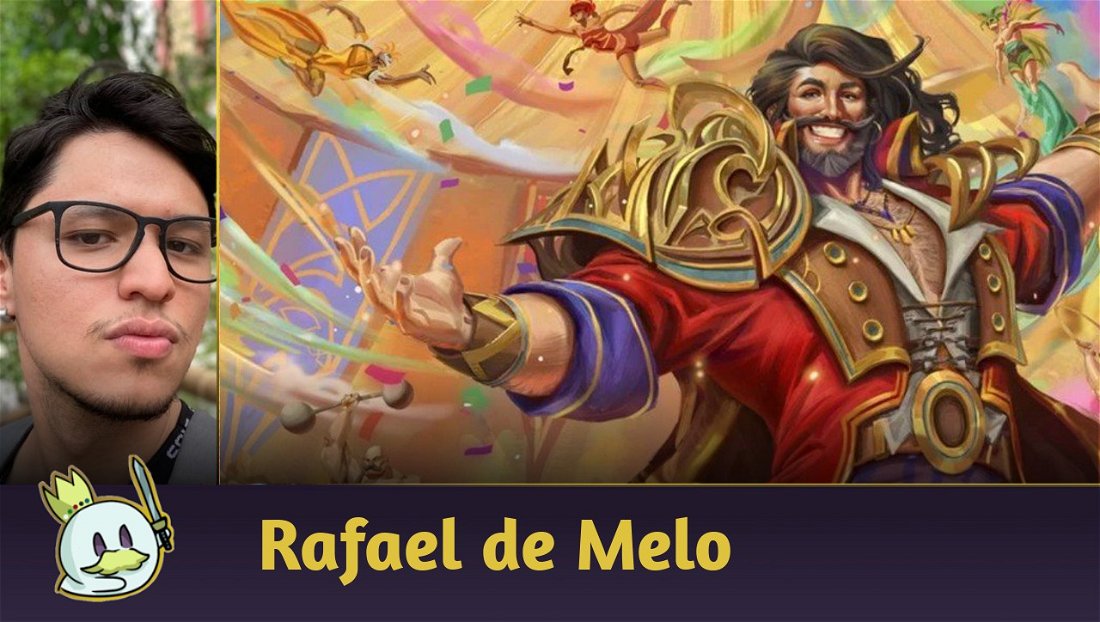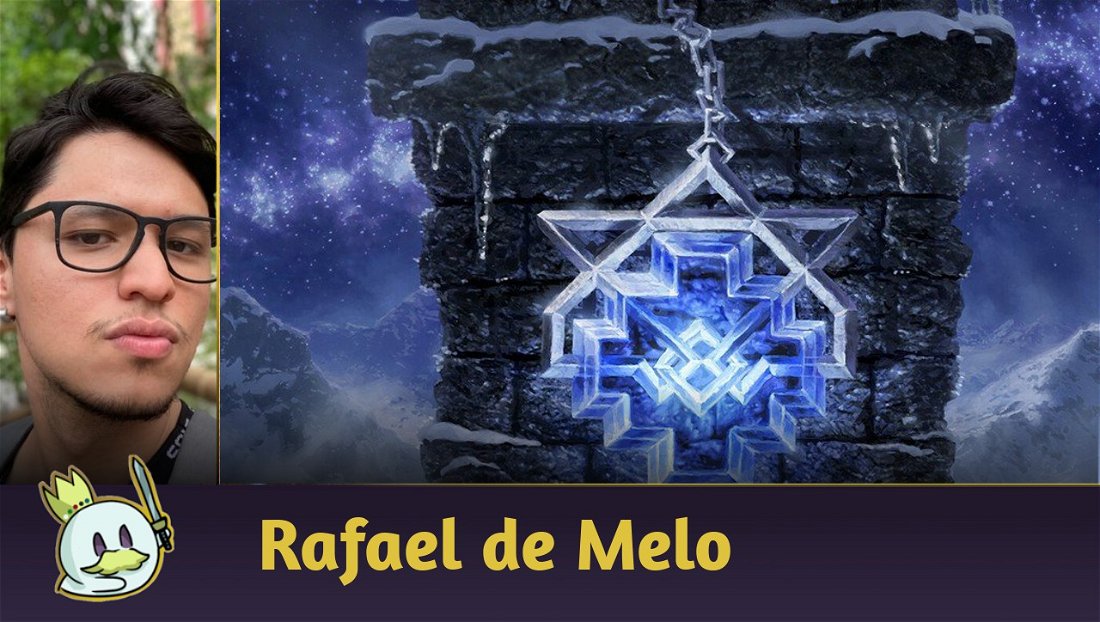Introduction
Before talking about today's deck, I'd like to share the idea of writing about Commoner and what motivates me to want to explore this format more and more.
This article is the first of many I intend to write about the common-only format. I, personally, am building and testing out various lists, and I have the goal of, still this year, physically build all possible playable decks in this format. But what is the reason that motivated me so much?
I am in love with cheaper formats (budgets) because they are excellent for new players who don't want to invest head first in the game, as it allows for strategies which don't have much space in other formats and, due to a reduced power level, it presents a challenge in the sense of "I can't use this card, what can I do to replace it?". So, with this series of articles, I'd like to show the vast variety of options this game can present without necessarily requiring you to invest in a Fyendal's Spring Tunic.
If you still don't know what the Commoner format is, I recommend you read this article first.
To start, I'll approach the first deck I'm building and playing, a deck that has a curious history and is currently one of the strongest heroes in the game: Iyslander.
Iyslander and her idea

Iyslander was released, first, as a Majestic card in the Everfest set, but this set didn't have the proper support to this hero. Wizard cards so far were relatively good, but they were much better used in Kano, whereas cards with the Ice talent weren't thought exactly with the Wizard class idea in mind, which caused this deck to have a weird build between the Ice cards (which were better used by Oldhim), red attacks and actions with arcane damage.
It all changes then with the release of Uprising. Besides introducing the new heroes Fai and Dromai, Iyslander gets the treatment she deserves. This set brings all the support this hero needed (including her specialization cards) Wizard cards that make sense for her (cards with the Ice talent which deal arcane damage and some others with the Fused mechanic) and the new weapon Waning Moon, which is better for her strategy than the weapon which was used until now, Kraken's Aethervein, and soon the main idea of the deck came about: a control strategy.
Besides all this support, two new things were extremely relevant for this hero: she gets an adult version (becoming valid in Classic Constructed) and her young version demotes in rarity, going from Majestic to Token (and therefore becomes valid in Commoner).
The idea of this hero is different from other heroes of the game. Iyslander's wish is to not only use her actions in your turn, but also in the opponent's turn. This hero, unlike Kano, performs actions in the opponent's turn at the same time she imposes control tools: be it by Frostbite tokens or through discards — making her the main hero for control strategy lovers.
Rapidly, Iyslander goes from a weird Blitz deck to one of the best decks across all formats. In Commoner, her strength isn't different.
Format-Based Differences
In a common-only format, the deck stands out in some aspects, as it doesn't have the many diverse tools the Blitz deck has.
The absence of tools such as Frost Hex, Channel Lake Frigid, Ice Eternal, Blizzard and the equipment Coronet Peak make this deck weaker regarding its strategy of controlling through punishments, but the strategy remains viable due to this hero's ability and common cards such as Waning Moon and Arctic Incarceration (3).

Many important cards in this deck are still present in the list. We can list, among them, Ice Bolt (3), Scalding Rain (3), Snapback (1), Frosting (3) and Cold Snap (3). So, the deck loses a bit of its punishing power, but all of its potential arcane damage and the Ice cards are still available — besides some attacks.
Despite these downsides, the deck still remains one of the best in the format due to still having its main damage sources available, and also still having some sort of control tools, though they are reduced.
Decklist Iyslander Commoner
It is possible to build the deck in two ways, though they are very similar: one focused exclusively in arcane damage and another also with this strategy, but with the addition of attack cards to establish an alternative win condition.
One of the things that stands out the most when we look at this list is the amount of blue cards. The reason is very simple: synergy with the hero.
Though effects and damages are reduced when compared to their yellow and red versions, this compensates from the moment we do these actions in the opponent's turns, therefore in all turns we want, if possible, to place a blue card in the arsenal and pass. The amount of blue cards allows us to have plenty of resource generation and perform heavier actions without problem as well.
Strategies
The deck's line is quite simple: put a blue card (preferably an Ice type) in the arsenal, the first chance you get in the opponent's turn (when they activate a Harmonized Kodachi, for instance), use this card from the arsenal and spend the resources left to activate Waning Moon. If your opponent decides to block arcane damage, they'll do it by spending resources from the hand — lowering their potential damage output in the turn.
For those who already understand this hero a bit more and play with other lists, you'll notice one more interesting thing about this list: the absence of two cost cards, such as Polar Cap (3) and Ice Bolt (3).
They are not bad and can be reused with no problem, but this list is focused on taking full advantage of the opponent's turn by just pitching one blue. With zero or one cost actions, it is possible to play them in the opponent's turn and activate Waning Moon's ability by pitching one blue — still leaving you with three cards in hand.
Blue Cards

Frosting (3), Scalding Rain (3), Aether Hail (3), Aether Dart (3) e Reverberate (3) are in the list due to the pure arcane damage that can be dealt in the opponent's turn. They all have extremely identical effects, except for a few such as Reverberate (3), but these are not in the list to take advantage of these extra effects, but rather due to their damage in instant speed.
Besides damage cards, we also count with various control tools, which we'll use to delay the opponent's turn. It's worth noting that many of these tools are of the Ice type — which triggers the hero's second ability.

Arctic Incarceration (3), besides being great as it costs zero, it creates two Frostbite if it's played from the arsenal, making it one of the best control tools in the deck. It's important to stress that in case this card is used in your turn, the Frostbite token remains on board even after the end of your turn.
Amulet of Ice is the only item in the deck and also the only one that doesn't have a defense, but its role is in being a tool to disrupt the opponent's hand or removing resources that would be used for cards that would come right afterward.
Though it is an item, it is still not an attack action, which allows it to be played in the opponent's turn and allows for the use of Waning Moon. Notice that there is a condition for this item to have its ability triggered, and for that, we need other cards that have the Fused mechanic to support us.
Brain Freeze (3) seems weak and very conditional, but in a format focused on using more efficient cards with the lowest cost possible, it isn't hard thinking of some cards that can be removed from the opponent's hand.
Dash uses Zero to Sixty (1), Ira, Crimson Haze uses Head Jab (3), Chane uses Seeds of Agony (1) and so on and so forth. In the worst scenarios, you'll still have information regarding your opponent's hand. In case you don't like its usability, Pry (3) is an excellent substitute.

Icebind (3) brings a bit of arcane damage, but in case its requirements are met, your opponent won't be able to use the arsenal card as it will be frozen. Also, with this frozen state, arsenal can become the target of the hand equipment we use, but we'll talk about equipment further on.
Cold Snap (3) is a card that gets more value when played from the arsenal. Its biggest utility is refilling itself, in case we play it from the arsenal, create a Frostbite to the opponent, use Waning Moon, and we therefore still have a hand with four cards after this play (considering we only pitched one blue).
In my article about Commoner's staples, I talked about how useful Winter's Bite (3) is with Ice talent heroes. With Iyslander, its utility is in it being Ice type and also being a great control tool. The go again ability allows us to perform even more actions in our turn.
Aether Icevein (3) brings everything the deck needs. If your deck is full of arcane damage cards and control tools, what is there to say about a card that performs both roles?
Any decision your opponent decides to do is valuable. If they decide to prevent arcane damage, they'll spend resources for that, and if they don't, they'll have to discard or spend two resources. It's not by accident that this action is currently suspended in Blitz.

The only blue card in the list that doesn't fit any of these goals is Winter's Grasp (3). As it can't be played in the opponent's turn (as it is an attack action), its role is to create resources, hold off three damage and be an Ice type for cards with Fused.
It can be used as an attack in case the match is in a very favorable state, but in general, we don't use it for attacking.
Red Cards
The list has but a few red cards, being used mostly to present some threat to the opponent.

Aether Hail (1), Aether Icevein (1), Frosting (1) and Snapback (1) are in the list due to their high arcane damage, and an honorable mention goes to Snapback (1), which can be played in the opponent turn.
Notice that, for that to be possible, it is necessary to play a Wizard card first, which doesn't include actions like Amulet of Ice or Cold Snap (3), so keep that in mind when planning out plays.

For our attacks, we use Wounded Bull (1) and Icy Encounter (1). Whereas Icy Encounter (1) performs the role of being aggressive and having a control tool, the other red attack, besides having a very high power, is very synergistic with the hero once Iyslander has naturally low health, so it is very easy to have an eight-power attack. This attack has shown itself to be very efficient when used by the champion Michael Hamilton in the last Flesh and Blood World Championship, so we'll do something similar here too.

As the deck presents weaknesses in case it gets hit with a lot of aggression, Sink Below (1) is a great defense as it blocks four, besides exchanging some not that useful card from our hand.
Equipment
In the last articles, I've been discussing how equipment is important in Flesh and Blood and how the most expensive cards in the decks are them, but here we can only use a few rare and common equipment, so the power level will be lowered in relation to the other formats, but that doesn't mean we'll have weak or irrelevant equipment.

For Iyslander, we'll use our main equipment as weapons of control.
Glacial Horns, alongside Conduit of Frostburn performs the role of controlling the opponent's arsenal and even destroy it due to the hand equipment effect.
Coat of Frost can delay the opponent's next turn (which is very nice when we're finishing the game, and we want to guarantee a strong hand for the next round) and Mage Master Boots is useful to sequence two action cards in our turn - once very few of our actions have natural go again.

What to use in the sideboard is very straightforward. Nullrune Gloves, Nullrune Boots and Spellfire Cloak make up three arcane barriers for mirror matches or against Kano.
Ironhide Helm and Ironhide Legs are there to face aggressive decks such as Dash and Bravo and Quelling Slippers is there against deck that deal less damage, but they are continuous such as Ira, Crimson Haze.

Waning Moon is the key to this deck.
This list is built thinking of the best way to extract maximum value and throughout this article, I explained how to use it, so as a result, we won't even consider using any other weapon.
Notice that, to use it, it is necessary to have done at least one non-attack action card in the turn, so keep this in mind to sequence your plays correctly.
Matchups
In this matchup section, I'll list the main decks in this format, but for lower tier decks, the logic used here is the same.
Dash
Dash has extremely powerful attacks with a lot of cadence to them, and with the Hyper Driver (1) and their equipment Heartened Cross Strap, they can have a turn that is impossible to recover from, so always try to punish with Frostbite as to annul the resource received with Hyper Driver (1).
Here Sink Below (1) is an extremely important card, and our red attacks are also excellent to pressure our opponent — once they won't use, usually, equipment with defense.

Ira, Crimson Haze
Ira, Crimson Haze has good value by using high cadence and cheap attacks. The greatest problem in this match is that the attacks have low power, but at each attack your health gets lower and lower until they are close to lethal.
Look for key blocking cards such as Whirling Mist Blossom and Salt the Wound and block bigger attacks. Use the hero's ability to punish the opponent's turn as much as you can and make their attacks cost more. It is important to remember that ninjas don't usually block well, and as a result red attacks are very important.

Bravo
This match is hard due to the extremely high attacks this hero has, such as Macho Grande (1) and combinations such as Anothos plus Pummel (1), so, because of that, preserve as much as you can your health until the right time to attack with the red attacks or use your red arcane damages.
Remember: the attacks used by Guardians have very high costs, so the more Frostbites and discards you do, the strongest will be your attack turn.

Iyslander
Usually, games against the same hero you're using tend to be 50-50 (that means the chances of victory for both players are the same). In case your opponent is using a list more focused on arcane damage, try to always pass your turn with more blue cards than they have, so you can use the Arcane Barrier 3 from your equipment and prevent this damage (particularly Waning Moon's damage), and, occasionally, your red attacks will win you the game.
The same goes for lists identical to the one presented in this article, with the addition of avoiding Icy Encounter (1) and other cards with on-hit effects' damages that might come along.

Final Thoughts
Iyslander is an extremely strong deck in Commoner, as it has many cards that its Blitz version uses without letting go of the strong strategy of playing in your opponent's turn. It holds off many different decks' pressure and, if your opponent isn't ready, it can deal arcane damage trouble free.
Iyslander isn't the best deck in the format, but definitely it sits beside the throne and carries the title of being one of the top decks to use.
I'd like to thank everyone who encouraged me to start this series and explore more and more the heroes of this game, particularly my dear Gustavo: may these articles grow your interest in this wonderful game and help you find your class.
Thank you for reading, and see you next time!















— Comments 0
, Reactions 1
Be the first to comment